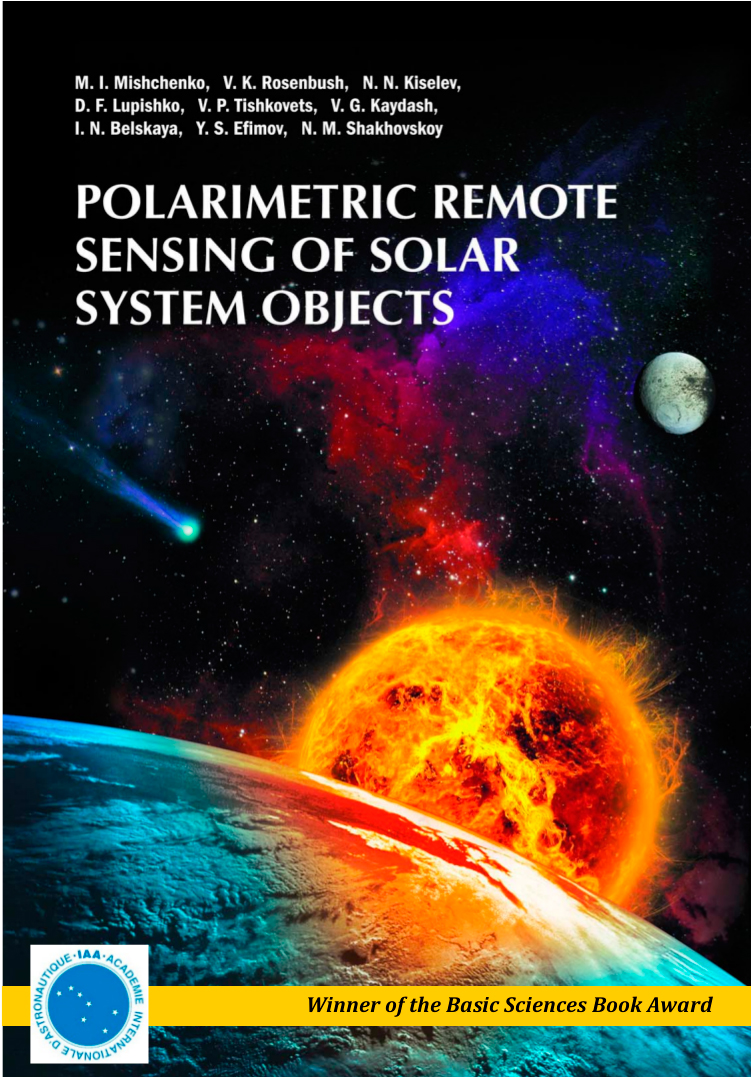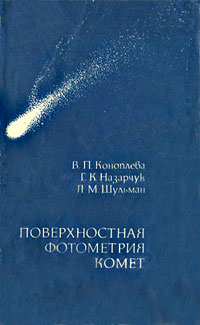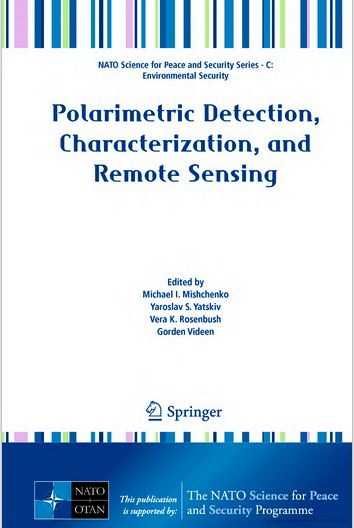Laboratory of MSSB physics: monographs
Mishchenko M.I., Rosenbush V.K., Kiselev N.N., Lupishko D.F., Tishkovets V.P., Kaydash V.G., Belskaya I.N., Efimov Y.S., Shakhovskoy N.M. Polarimetric remote sensing of Solar System objects
Akademperiodyka, Kyiv, 291 p. Basic Sciences Book Award of the International Academy of Astronautics (2010).
doi: 10.15407/akademperiodyka.134.291
 This book outlines the basic physical principles and practical methods of polarimetric remote sensing of Solar System objects and summarizes numerous advanced applications of polarimetry in geophysics and planetary astrophysics. In the first chapter we present a complete and rigorous theory of electromagnetic scattering by disperse media directly based on the Maxwell equations and describe advanced physically based modeling tools. This is followed, in Chapter 2, by a theoretical analysis of polarimetry as a remote-sensing tool and an outline of basic principles of polarimetric measurements and their practical implementations. In Chapters 3 and 4, we describe the results of extensive ground-based, aircraft, and spacecraft observations of numerous Solar System objects (the Earth and other planets, planetary satellites, Saturn’s rings, asteroids, trans-Neptunian objects, and comets). Theoretical analyses of these data are used to retrieve optical and physical characteristics of planetary surfaces and atmospheres as well as to identify a number of new phenomena and effects.
This book outlines the basic physical principles and practical methods of polarimetric remote sensing of Solar System objects and summarizes numerous advanced applications of polarimetry in geophysics and planetary astrophysics. In the first chapter we present a complete and rigorous theory of electromagnetic scattering by disperse media directly based on the Maxwell equations and describe advanced physically based modeling tools. This is followed, in Chapter 2, by a theoretical analysis of polarimetry as a remote-sensing tool and an outline of basic principles of polarimetric measurements and their practical implementations. In Chapters 3 and 4, we describe the results of extensive ground-based, aircraft, and spacecraft observations of numerous Solar System objects (the Earth and other planets, planetary satellites, Saturn’s rings, asteroids, trans-Neptunian objects, and comets). Theoretical analyses of these data are used to retrieve optical and physical characteristics of planetary surfaces and atmospheres as well as to identify a number of new phenomena and effects.
This monograph is intended for science professionals, educators, and graduate students specializing in remote sensing, astrophysics, atmospheric physics, optics of disperse and disordered media, and optical particle characterization
L.M.Shulman. Cometary nuclei
Nauka, Moscow,1987, 230 pp. (in Russian)
 The physical model of a comet nucleus is described. The theoretical basement, which allows getting characteristics of cometary nuclei from the analysis of photometric, spectral and other observations of comets, is proposed. The integrity of nuclei, their chemical composition, thermal regime, specific features of cometary ice sublimation, formation and behavior of a surface dust layer are considered. Information is provided on adjacent sections of physics, chemistry, cryogenics, and others, which is necessary in order to work as a researcher on cometary nuclei.
The physical model of a comet nucleus is described. The theoretical basement, which allows getting characteristics of cometary nuclei from the analysis of photometric, spectral and other observations of comets, is proposed. The integrity of nuclei, their chemical composition, thermal regime, specific features of cometary ice sublimation, formation and behavior of a surface dust layer are considered. Information is provided on adjacent sections of physics, chemistry, cryogenics, and others, which is necessary in order to work as a researcher on cometary nuclei.
A special section outlines results of the spacecraft investigation of Halley's comet.
The book is a good manual for astronomers and physicists, graduate students, and students.
Konopleva V., Nasarchuk G., Shulman L. Surface photometry of comets
Naukova dumka, Kyiv, 1977, 266 pp. (in Russian)
 The monograph describes the technique of surface photometry of comets, theoretical models of the brightness distribution, and methods for obtaining information about the physical conditions and atmospheres of comets using surface photometry data. Tables are provided that allow to speed up significantly the time-consuming process of primary photometric processing of direct images and spectra of comets, as well as tables for determining the physical parameters of cometary atmospheres by comparing the observed distribution of surface brightness in a comet image with theoretical models. The parameters found by the proposed technique can be used to estimate the characteristics of the interplanetary medium in the region of space in which the comet was at the time of observation.
The monograph describes the technique of surface photometry of comets, theoretical models of the brightness distribution, and methods for obtaining information about the physical conditions and atmospheres of comets using surface photometry data. Tables are provided that allow to speed up significantly the time-consuming process of primary photometric processing of direct images and spectra of comets, as well as tables for determining the physical parameters of cometary atmospheres by comparing the observed distribution of surface brightness in a comet image with theoretical models. The parameters found by the proposed technique can be used to estimate the characteristics of the interplanetary medium in the region of space in which the comet was at the time of observation.
Designed for researchers at astronomical institutions and universities, undergraduate and graduate students specializing in astrophysics.
L. Shulman. Dynamics of cometary atmospheres. Neutral gas.
Naukova dumka, Kyiv, 1972, 243 pp. (in Russian)
 The monograph presents the theory of the motion of neutral gas in the atmospheres of comets. The purpose of the monograph is to give the necessary tool for calculating the physical conditions in the different layers of a neutral-gas atmosphere. The following problems are considered: the identification of parent molecules based on observed radicals; the transition of neutral molecules into the atmosphere; the movement of gases in the zone of collisions; the heating of gas in the zone of collisions due to photodissociation and the presence of dust; the behavior of dust particles (ejected from the nucleus and newly formed in the atmosphere by condensation or photopolymerization process) in a dusty atmosphere; temperature anisotropy in the domain of transition to the regime of free molecular flow. The case when the free-molecular flow regime prevails in the entire cometary atmosphere is investigated, taking into account the rotation of the nucleus and the photodissociation kinetics.
The monograph presents the theory of the motion of neutral gas in the atmospheres of comets. The purpose of the monograph is to give the necessary tool for calculating the physical conditions in the different layers of a neutral-gas atmosphere. The following problems are considered: the identification of parent molecules based on observed radicals; the transition of neutral molecules into the atmosphere; the movement of gases in the zone of collisions; the heating of gas in the zone of collisions due to photodissociation and the presence of dust; the behavior of dust particles (ejected from the nucleus and newly formed in the atmosphere by condensation or photopolymerization process) in a dusty atmosphere; temperature anisotropy in the domain of transition to the regime of free molecular flow. The case when the free-molecular flow regime prevails in the entire cometary atmosphere is investigated, taking into account the rotation of the nucleus and the photodissociation kinetics.
For cases that are most commonly encountered in practice, equations are obtained that allow one to calculate the distribution of surface brightness of comets; the calculation technique for an arbitrary case is outlined.
The book is designed for scientists, students, and postgraduate students specializing in astrophysics.
SECTIONS IN MONOGRAPHS
Mishchenko M.I., Yatskiv Ya.S., Rosenbush V.K., Videen G. Eds. 2011. Polarimetric detection, сharacterization and remote sensing
Springer, Dordrecht, The Netherlands, 550 р.
 The NATO Advanced Study Institute (ASI)on "Special Detection Technique (Polarimetrv) and Remote Sensing” took place in Kyiv, Ukraine, 12-25 September 2010. The main focus of the meeting was photopolarimetry, a rapidly developing, multidisciplinary topic with numerous military, ecological remote-sensing, astrophysical, biomedical, and technological applications fl-9|. Typical remote-sensing instruments measure the total intensity of the light scattered by a system of interest. Although the results of such measurements can be extremely valuable, they carry only a fraction of potentially useful information contained in the scattered light. The remaining information is coded in the polarization state of the light. As the need for accurate optical characterization and diagnostic techniques is increasing, it is important to find improved ways of extracting the additional information contained within the polarization slate of the measured light...
The NATO Advanced Study Institute (ASI)on "Special Detection Technique (Polarimetrv) and Remote Sensing” took place in Kyiv, Ukraine, 12-25 September 2010. The main focus of the meeting was photopolarimetry, a rapidly developing, multidisciplinary topic with numerous military, ecological remote-sensing, astrophysical, biomedical, and technological applications fl-9|. Typical remote-sensing instruments measure the total intensity of the light scattered by a system of interest. Although the results of such measurements can be extremely valuable, they carry only a fraction of potentially useful information contained in the scattered light. The remaining information is coded in the polarization state of the light. As the need for accurate optical characterization and diagnostic techniques is increasing, it is important to find improved ways of extracting the additional information contained within the polarization slate of the measured light...
Kolokolova, L., J. Hough, and A.-C. Levasseur-Regourd, Eds., 2015: Polarimetry of Stars and Planetary Systems.
Cambridge University Press, Cambridge. 560 pp.
 Summarising the striking advances of the last two decades, this reliable introduction to modern astronomical polarimetry provides a comprehensive review of state-of-the-art techniques, models and research methods. Focusing on optical and near-infrared wavelengths, each detailed, up-to-date chapter addresses a different facet of recent innovations, including new instrumentation, techniques and theories; new methods based on laboratory studies, enabling the modeling of polarimetric characteristics for a wide variety of astronomical objects; emerging fields of polarimetric exploration, including proto-planetary and debris discs, icy satellites, transneptunian objects, exoplanets, and the search for extraterrestrial life; and unique results produced by space telescopes, and polarimeters aboard exploratory spacecraft. With contributions from an international team of accomplished researchers, this is an ideal resource for astronomers and researchers working in astrophysics, earth sciences, and remote sensing keen to learn more about this valuable diagnostic tool. The book is dedicated to the memory of renowned polarimetrist Tom Gehrels.
Summarising the striking advances of the last two decades, this reliable introduction to modern astronomical polarimetry provides a comprehensive review of state-of-the-art techniques, models and research methods. Focusing on optical and near-infrared wavelengths, each detailed, up-to-date chapter addresses a different facet of recent innovations, including new instrumentation, techniques and theories; new methods based on laboratory studies, enabling the modeling of polarimetric characteristics for a wide variety of astronomical objects; emerging fields of polarimetric exploration, including proto-planetary and debris discs, icy satellites, transneptunian objects, exoplanets, and the search for extraterrestrial life; and unique results produced by space telescopes, and polarimeters aboard exploratory spacecraft. With contributions from an international team of accomplished researchers, this is an ideal resource for astronomers and researchers working in astrophysics, earth sciences, and remote sensing keen to learn more about this valuable diagnostic tool. The book is dedicated to the memory of renowned polarimetrist Tom Gehrels.

Videen,G., Ya. Yatskiv, and M. Mishchenko, Eds., 2004: Photopolarimetry in Remote Sensing
Kluwer Academic Publishers, Dordrecht, The Netherlands. 503 pp.

Videen,G. and M. Kocifaj, Eds., 2002: Optics of Cosmic Dust
Kluwer Academic Publishers, Dordrecht, The Netherlands. 320 pp.
Optics of Cosmic Dust describes what we currently know about cosmic dust, how we know it, and the research efforts undertaken to provide that knowledge. Areas treated include observational information, dust morphology and chemistry, light-scattering models, characterisation methodologies, and backscatter polarisation and dynamics. Suitable as an introductory text, the book is also a reference guide for the advanced researcher.


